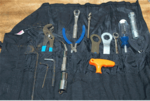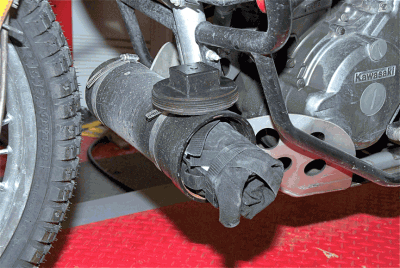Touring tip: When it's tool time on the road
 Published with the permission of RoadRUNNER Motorcycle Touring & Travel Magazine for Overland Tech & Travel / Overland Expo only. Not for sale or distribution.
Published with the permission of RoadRUNNER Motorcycle Touring & Travel Magazine for Overland Tech & Travel / Overland Expo only. Not for sale or distribution. If you’re like most adventure motorcyclists, you don’t want any type of mechanical problem to deal with during a motorcycle tour. And, of course, the best way to keep that from happening is a heavy dose of preventative medicine before your bike ever leaves the garage. But unforeseen mechanical malfunctions can and do happen out on the road. So, taking selected tools with you and knowing how to use them are sensible precautions for any touring rider.
If you’re like most adventure motorcyclists, you don’t want any type of mechanical problem to deal with during a motorcycle tour. And, of course, the best way to keep that from happening is a heavy dose of preventative medicine before your bike ever leaves the garage. But unforeseen mechanical malfunctions can and do happen out on the road. So, taking selected tools with you and knowing how to use them are sensible precautions for any touring rider.
Key Assumptions: If you ask 10 different riders for their list of necessary tools to have along, you may get 10 different lists. That’s probably because of the assumptions each person is making in several key areas:
- Length of Trip: The longer you expect to be on the road the more likely it is that something on the bike will need repair. If your trip involves going around the globe, then many more tools and spare parts will be needed than for a weekend jaunt to the mountains.
- Type of Bike & Riding: All other things being equal, dual-sport riding and adventure touring are more likely to result in something coming loose or a bike going down than while street riding.
- Riding Environment: Riding in remote locations usually requires riders to be more self-reliant in fixing whatever needs repairing.
- Number of Riders in the Group: The solitary rider must carry all of the tools and spare parts he or she might need. In group riding situations the load can be spread amongst the riders.
- Mechanical Expertise of Rider(s): There’s no point in carrying a lot of tools and spare parts if you don’t know how to use them to make the repairs. Riders traveling long distances in remote areas, however, should have the requisite mechanical expertise and equipment to repair most any type of mechanical malfunction.
Most Common Malfunctions on the Road
It behooves all riders to have the necessary tools and skills to fix the motorcycle malfunctions that are most likely to occur on tour:
- Flat Tire: For tubeless tires, there are a number of kits available in the marketplace that enable riders to perform a temporary repair, without removing the tire from the bike. Besides the CO2 cartridges that come with these kits, it’s a good idea to have a small compressor to ensure that the re-inflated tire has sufficient pressure for safe riding. (You’ll need a tire pressure gauge to know for sure.) However, riders should have a professional technician repair or replace the tire as soon as possible.
For tube-type tires, the repair process is more involved and requires more tools. (Helpful hint: Even if a tire is marked “tubeless” on the outside, if it’s mounted on a spoke wheel, a tube will be required on the inside.) The wheel and tire must be removed from the bike, so the necessary wrenches should be on board for both the front and rear axles. Tire irons and a bead buster will be needed to remove the tube for repair or replacement.
- Electrical Malfunction: The most common types of electrical problems are blown fuses and burned out light bulbs. So, it’s important to know where the fuses are located on the bike and to have spares with the correct wattage. Also, it’s a good idea to carry extra bulbs for the headlight, taillight and turn signals, and to have the correct tools and expertise to replace them.
- Broken Cable(s) and Levers(s): Broken cables are a potential issue only on bikes with a manual clutch (i.e., non-hydraulic) or drum brakes. In these situations, carry an extra cable(s) already zip-tied in place with the one in use. This will dramatically reduce repair time if a cable breaks.
A broken clutch or brake lever, usually caused by a fall, can be a big problem on the road. Although the risk of a broken brake lever is somewhat hedged by the fact that there are two of them, there is only one clutch lever and it’s pretty hard to ride a motorcycle without the benefit of a clutch. Consequently, taking extra levers is a good insurance policy.
- Fouled Spark Plug(s): It’s always a good idea to have extra spark plugs, which have been pre-gapped, along on your trips. They don’t take up much space and can make the difference of whether you're stranded or not. Obviously, the proper wrenches will be needed to replace them.
- Low Motor Oil: If your bike has a history of using oil, it makes a lot of sense to take along a quart of motorcycle oil, which might otherwise be difficult to find on a Sunday, Monday or Holiday.
- Broken Bodywork: Sometimes a spill can leave cracked and loose body parts, which can make the motorcycle unsafe to ride. A roll of duct tape can often do wonders in these situations.
The above list is not an exhaustive one, but it does represent the type of malfunctions that could occur on a trip of several weeks.
 Customizing Your Toolkit
Customizing Your Toolkit
Unfortunately, the tool kits that come with bikes are often of inferior quality. You don’t want a wrench breaking or rounding off a nut when you’re relying on it to get you out of a predicament. Consequently, I’m an advocate of building a customized toolkit that’s designed around the type of repairs you may have to perform on the road. Based on the key assumptions about your touring plans and the types of repairs that are likely to occur, acquire the specific, high quality sockets, ratchets, screwdrivers and other wrenches that are needed to perform these tasks. It’s OK to use items from the manufacturers toolkit if they’re of sufficient quality. To make sure you have what’s needed, use your tool kit while still at home to remove the wheels, change a spark plug, replace a light bulb, etc.
I found that the customized tool kit for my dual-sport bike would no longer fit under the seat, so I fashioned a separate container out of PVC pipe and mounted it on the skid plate. So far I’ve been able to make any needed repairs on the road - but the best tools to have along are still a cell phone and a credit card.
Published with the permission of RoadRUNNER Motorcycle Touring & Travel Magazine for Overland Tech & Travel / Overland Expo only. Not for sale or distribution.
